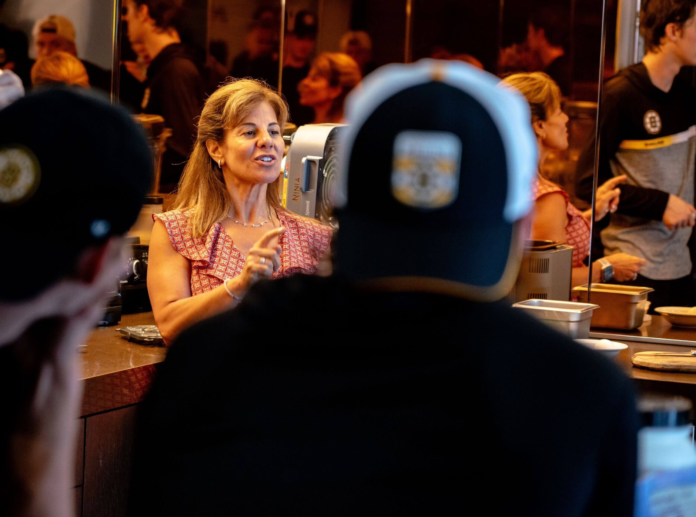BRIGHTON, Mass. — The players had all the oats they wanted within reach. Containers of almond milk were available. Their options included sunflower seed butter, almond butter and peanut butter. They could choose between chocolate and vanilla protein powder. They could customize their creations with cinnamon or vanilla extract.
Advertisement
Some players might have taken it too far.
On July 3 at Warrior Ice Arena, the Bruins’ practice facility, nutritionist Julie Nicoletti had given the order to the 32 participants in the team’s annual development camp: They were to make overnight oats and protein balls. She had provided recipes and ingredients.
Nicoletti, the founder of the nutrition company Kinetic Fuel, divided the players into three groups. They would be timed. Variables such as cleanliness and presentation would be judged.
Two days later, Matt Poitras was still griping about the competition’s outcome. The 19-year-old’s group had come up short. The prevailing theory was that he and his teammates had sprinkled too much chocolate into their creation.
“I think it’s a bit controversial,” the 2022 second-rounder said with a smile. “We put in a good effort. We probably should have won.”
Making good choices
By now, NHL players know the value of nutrition. They buy organic food. They stay away from junk. Their employers feed them well, from breakfast at the rink to a pregame meal after the morning skate to the postgame dinner on the plane.
At home, they are comfortable in the kitchen. Veterans know that proper nutrition optimizes qualities such as performance, recovery, mental processing and immune response.
The league’s next generation may not be as ready to incorporate what it takes to pursue good nutrition.
Some 18-year-olds, for example, have never shopped or cooked for themselves. Parents and billet families have done the work for them. Young players are of the age when cafeterias and team-provided meals do a lot of the heavy lifting. Similarly aged non-athletes on campus tend to chase cheap eats, some of which do not qualify as healthy.
“A lot of my friends back at school that aren’t on the team are on the ramen and easy mac and cheese,” said Jake Schmaltz, a junior-to-be at North Dakota.
Advertisement
Even in the NHL, it wasn’t that long ago that clean eating — to say nothing of moderation in drinking — was a foreign concept.
“It just wasn’t part of the culture. It was important for us to meet for lunch,” said former NHLer Jamie Langenbrunner, flashing air quotes to emphasize the term “after practice.”
Those days are just about over. Players are aware that sugar, alcohol, preservatives and processed food are not worth their convenience.
“They’ve become savvier,” said Nicoletti, who has worked with the Bruins for nine years. “They’re cooking more. They’ve got more education. When I started, I felt like I had to convince them that nutrition mattered. Now, they all get that.”
Youngsters who recognize the value of nutrition want to know what to do. Some want to put on good weight to survive the sport’s rigor.
Riley Duran, a 21-year-old forward, saw the pounds drop in-season as a freshman and sophomore at Providence College. The 6-foot-2, 190-pounder does not want that to happen a third straight year.
So Duran eats six meals daily. He describes his typical day as nonstop eating.
His mother, Lori, it turns out, is a nutritionist at Woburn High School. The family shops at Whole Foods. Duran has never eaten at McDonald’s.
Other players, meanwhile, are trying to lean out. All want to be pointed in the right direction.
“Out of a 10, probably a two,” Poitras, 19, said of his comfort in the kitchen. “I should probably start taking some lessons from my mom on cooking, because I have no clue what I’m doing.”
Nicoletti has tips.
How to shop, prepare and cook
1. Some first-year pros may be on their own for the first time in their lives. Even before they hit the supermarket, they’ll need kitchen essentials. Wedding registrants know that even a list of basics — cutting board, kitchen knife, blender, spatula, wooden spoon, measuring cups, skillet, baking sheet, utensils — can get long.
Advertisement
2. One appliance Nicoletti plugs is an Instant Pot. It is a multipurpose item that can steam, saute, slow cook and pressure cook. By putting rice, broccoli, bone broth and chicken in the Instant Pot, a player can have a quick, well-rounded dinner.
“Close the lid. Press the button,” Nicoletti said. “Fifteen minutes later, it’s done.”
3. At the supermarket, fruits, vegetables, poultry, meat and seafood are the main groups. Some of the staples: berries, melons, spinach, broccoli, tomatoes, boneless skinless chicken breasts, lean cuts of beef, salmon, sardines.
4. Frozen fruits and vegetables are good to buy, too. They are convenient for smoothies and stir-fries, especially when pressed for time. Some items may even taste better than fresh varieties because of the speed at which they go from the tree to the freezer.
“It’s actually frozen faster than it’s sometimes shipped,” Nicoletti said. “They have to freeze things within four hours, versus putting it on a truck and having it shipped from California.”
Nicoletti cautions the players, though, about fruit packaged in syrup or vegetables that come with cheese.
5. Once the kitchen is stocked, Nicoletti recommends learning how to dice onions. This way, players can have a base of aromatics they can customize with their preferred protein. Ground beef or ground turkey, for example, can be added to the onions along with salt, pepper and garlic. This could accompany steamed rice and vegetables — both of which could be prepared in the Instant Pot.
6. Customization is not only easy but also encourages players to pursue variety. Smoothies can include berries one day and bananas the next.
Players could make enough overnight oats for a week. Then they can play with different flavors of protein powder, fruits, cinnamon, vanilla, nut butter or chocolate.
Advertisement
“You can totally change the flavors,” Nicoletti said. “They saw they could do it in 10 minutes. They could do it in a dorm room. They can do it in a billet family’s house. They can do it if they’re living by themselves for the first time in Providence. If you can do it in 10 minutes, there’s no excuse not to.”
(Photo of Julie Nicoletti courtesy of the Boston Bruins)




